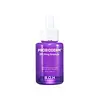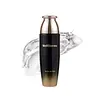What's inside
What's inside
 Key Ingredients
Key Ingredients

 Benefits
Benefits

 Concerns
Concerns

 Ingredients Side-by-side
Ingredients Side-by-side

Lactobacillus Ferment Lysate
Skin ConditioningWater
Skin ConditioningIsopentyldiol
HumectantGlycerin
HumectantCaprylic/Capric Triglyceride
MaskingPolyglycerin-3
Humectant1,2-Hexanediol
Skin ConditioningCetyl Ethylhexanoate
EmollientLactobacillus Ferment
Skin ConditioningFructooligosaccharides
HumectantFructan
Skin ConditioningInulin
Skin ConditioningPanthenol
Skin ConditioningBetaine
HumectantBeta-Glucan
Skin ConditioningAdenosine
Skin ConditioningSaponins
CleansingSoluble Proteoglycan
Skin ConditioningNonapeptide-1
Skin ConditioningAcetyl Tetrapeptide-9
Skin ConditioningAcetyl Tetrapeptide-5
HumectantAcetyl Hexapeptide-1
Skin ConditioningAcetyl Hexapeptide-8
HumectantPalmitoyl Tripeptide-8
Skin ConditioningDipeptide Diaminobutyroyl Benzylamide Diacetate
Skin ConditioningCopper Tripeptide-1
Skin ConditioningTripeptide-1
Skin ConditioningPalmitoyl Tetrapeptide-7
Skin ConditioningPalmitoyl Tripeptide-1
Skin ConditioningPalmitoyl Tripeptide-5
Skin ConditioningPalmitoyl Pentapeptide-4
Skin ConditioningPalmitoyl Hexapeptide-12
Skin ConditioningPentapeptide-3
Skin ConditioningHexapeptide-9
Skin ConditioningOligopeptide-2
Skin ConditioningGlyceryl Citrate/Lactate/Linoleate/Oleate
EmulsifyingMalt Extract
Skin ProtectingDioscorea Japonica Root Extract
Skin ConditioningElaeis Guineensis Oil
EmollientHydroxyethyl Acrylate/Sodium Acryloyldimethyl Taurate Copolymer
Emulsion StabilisingPolyacrylate Crosspolymer-6
Emulsion StabilisingMaltodextrin
AbsorbentEthylhexylglycerin
Skin ConditioningPropanediol
SolventGlyceryl Polymethacrylate
Sodium Polyacrylate
AbsorbentSorbitan Isostearate
EmulsifyingAlgin
MaskingBiosaccharide Gum-4
Skin ConditioningCyanocobalamin
Skin ConditioningCetearyl Glucoside
EmulsifyingCetearyl Alcohol
EmollientButylene Glycol
HumectantSodium Stearoyl Glutamate
CleansingTocopherol
AntioxidantXanthan Gum
EmulsifyingHydrolyzed Corn Starch
HumectantSucrose
HumectantSodium Phosphate
BufferingCaprylyl Glycol
EmollientMineral Salts
Skin ConditioningDextran
Disodium Phosphate
BufferingParfum
MaskingLactobacillus Ferment Lysate, Water, Isopentyldiol, Glycerin, Caprylic/Capric Triglyceride, Polyglycerin-3, 1,2-Hexanediol, Cetyl Ethylhexanoate, Lactobacillus Ferment, Fructooligosaccharides, Fructan, Inulin, Panthenol, Betaine, Beta-Glucan, Adenosine, Saponins, Soluble Proteoglycan, Nonapeptide-1, Acetyl Tetrapeptide-9, Acetyl Tetrapeptide-5, Acetyl Hexapeptide-1, Acetyl Hexapeptide-8, Palmitoyl Tripeptide-8, Dipeptide Diaminobutyroyl Benzylamide Diacetate, Copper Tripeptide-1, Tripeptide-1, Palmitoyl Tetrapeptide-7, Palmitoyl Tripeptide-1, Palmitoyl Tripeptide-5, Palmitoyl Pentapeptide-4, Palmitoyl Hexapeptide-12, Pentapeptide-3, Hexapeptide-9, Oligopeptide-2, Glyceryl Citrate/Lactate/Linoleate/Oleate, Malt Extract, Dioscorea Japonica Root Extract, Elaeis Guineensis Oil, Hydroxyethyl Acrylate/Sodium Acryloyldimethyl Taurate Copolymer, Polyacrylate Crosspolymer-6, Maltodextrin, Ethylhexylglycerin, Propanediol, Glyceryl Polymethacrylate, Sodium Polyacrylate, Sorbitan Isostearate, Algin, Biosaccharide Gum-4, Cyanocobalamin, Cetearyl Glucoside, Cetearyl Alcohol, Butylene Glycol, Sodium Stearoyl Glutamate, Tocopherol, Xanthan Gum, Hydrolyzed Corn Starch, Sucrose, Sodium Phosphate, Caprylyl Glycol, Mineral Salts, Dextran, Disodium Phosphate, Parfum
Ingredients Explained
These ingredients are found in both products.
Ingredients higher up in an ingredient list are typically present in a larger amount.
Betaine is a common humectant (a substance that promotes retention of moisture). It's known to be gentle on the skin and can help balance hydration.
This ingredient is best for improving hydration and soothing irritated skin. Studies also show it helps even out skin tone.
Fun fact: Betaine is naturally created in the skin and body. The kind found within cosmetic products can be either plant-derived or synthetic.
Another name for betaine is trimethylglycine.
Learn more about BetaineEthylhexylglycerin (we can't pronounce this either) is commonly used as a preservative and skin softener. It is derived from glyceryl.
You might see Ethylhexylglycerin often paired with other preservatives such as phenoxyethanol. Ethylhexylglycerin has been found to increase the effectiveness of these other preservatives.
Parfum is a catch-all term for an ingredient or more that is used to give a scent to products.
Also called "fragrance", this ingredient can be a blend of hundreds of chemicals or plant oils. This means every product with "fragrance" or "parfum" in the ingredients list is a different mixture.
For instance, Habanolide is a proprietary trade name for a specific aroma chemical. When used as a fragrance ingredient in cosmetics, most aroma chemicals fall under the broad labeling category of “FRAGRANCE” or “PARFUM” according to EU and US regulations.
The term 'parfum' or 'fragrance' is not regulated in many countries. In many cases, it is up to the brand to define this term.
For instance, many brands choose to label themselves as "fragrance-free" because they are not using synthetic fragrances. However, their products may still contain ingredients such as essential oils that are considered a fragrance by INCI standards.
One example is Calendula flower extract. Calendula is an essential oil that still imparts a scent or 'fragrance'.
Depending on the blend, the ingredients in the mixture can cause allergies and sensitivities on the skin. Some ingredients that are known EU allergens include linalool and citronellol.
Parfum can also be used to mask or cover an unpleasant scent.
The bottom line is: not all fragrances/parfum/ingredients are created equally. If you are worried about fragrances, we recommend taking a closer look at an ingredient. And of course, we always recommend speaking with a professional.
Learn more about ParfumWater. It's the most common cosmetic ingredient of all. You'll usually see it at the top of ingredient lists, meaning that it makes up the largest part of the product.
So why is it so popular? Water most often acts as a solvent - this means that it helps dissolve other ingredients into the formulation.
You'll also recognize water as that liquid we all need to stay alive. If you see this, drink a glass of water. Stay hydrated!
Learn more about Water